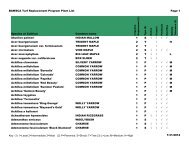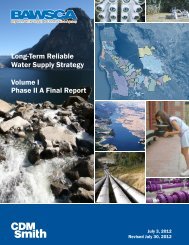SFPUC Wholesale Customer Water Demand Projections ... - BAWSCA
SFPUC Wholesale Customer Water Demand Projections ... - BAWSCA
SFPUC Wholesale Customer Water Demand Projections ... - BAWSCA
Create successful ePaper yourself
Turn your PDF publications into a flip-book with our unique Google optimized e-Paper software.
SECTIONFOUR<br />
<strong>Water</strong> <strong>Demand</strong> Forecasting<br />
as well. Year 2000 UWMPs did not have access to the ABAG 2002 report and were based on<br />
older ABAG or other projections.<br />
• <strong>Water</strong> Agency <strong>Water</strong> Master Plans (WMPs) – Some agencies provided a WMP for use in<br />
projections, if the WMP was more recent than the latest published UWMP. In some cases the<br />
demand projections were presented; however, the population and/or employment forecasts<br />
used were not always provided. In some cases the demand projections were based on land<br />
use forecasts.<br />
• Bay Area <strong>Water</strong> Users Association 2001–2002 Annual Survey (BAWUA 2002) -<br />
Population estimates for wholesale customer service areas are published in the BAWUA<br />
Annual Survey each year. Historical population estimates are provided as well as forecasted<br />
population estimates for each decade. The BAWUA 2001–2002 Annual Survey provides<br />
projections out to the year 2030 (BAWUA 2002). BAWUA estimates are provided by the<br />
wholesale customer to BAWUA and correspond directly with the wholesale customer service<br />
area boundaries. BAWUA does not perform any analysis to verify these projections.<br />
• Agency <strong>Demand</strong> or Forecast Studies - Some agencies provided demand or forecast studies<br />
with their own water demand or population projections based on their own evaluations,<br />
similar to WMPs. These studies were evaluated as an alternate projection source in the DSS<br />
Model.<br />
Development of Yearly <strong>Projections</strong> to the Year 2030<br />
Typically, only the BAWUA Annual Survey projected the population to the year 2030 as desired<br />
for this study (BAWUA 2002). In addition, none of the population projection sources provided<br />
yearly projections, although most provided projections in 5- or 10-year increments. Therefore,<br />
the following steps were taken to create yearly projections to 2030 for each of the sources, as<br />
necessary:<br />
• The population increase for each 5- or 10-year increment was divided evenly and applied<br />
yearly throughout the 5- or 10-year period to form a linear yearly population projection<br />
between increments<br />
• For ABAG, the population from 2025–2030 was estimated using the 2020–2025 population<br />
growth rate applied to the 2025 estimate and carried forward linearly at that rate to 2030<br />
Population Growth Rates<br />
Population growth rates were extrapolated from the yearly population projections to 2030 for<br />
each source, to utilize the population projections with the DSS 2001 base-year population for<br />
each wholesale customer’s service area.<br />
To reconcile the ABAG projections with the wholesale customer service areas, it was necessary<br />
to create service area blends of ABAG cities, summarized in Table 3-4. A yearly service area<br />
population growth rate for the years 2001–2030 was then created for each wholesale customer<br />
using the ABAG city’s yearly growth rates at those percentages.<br />
4-3







